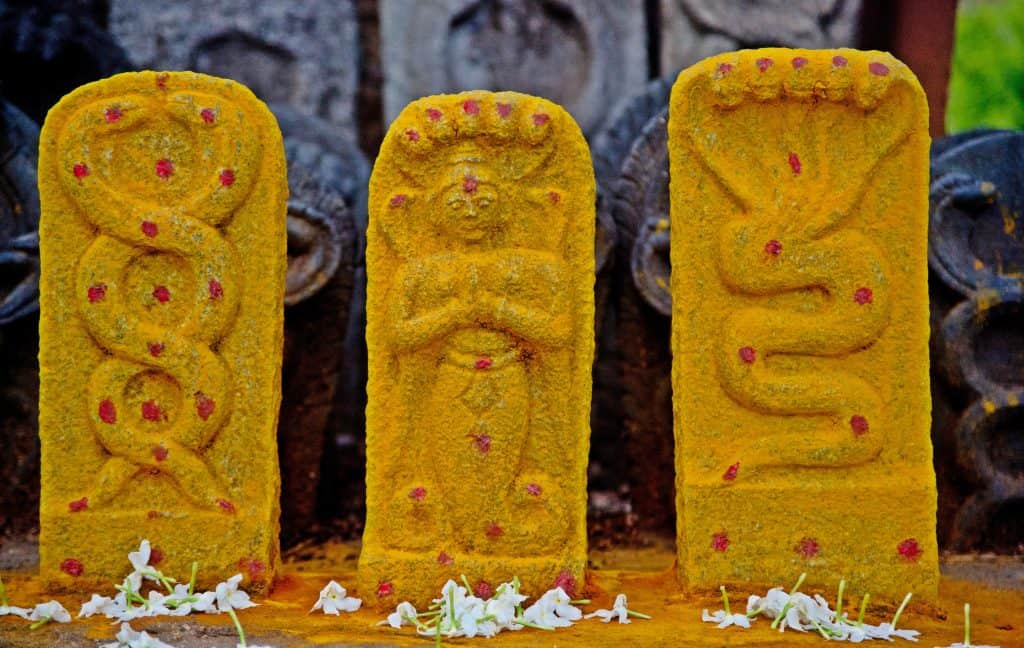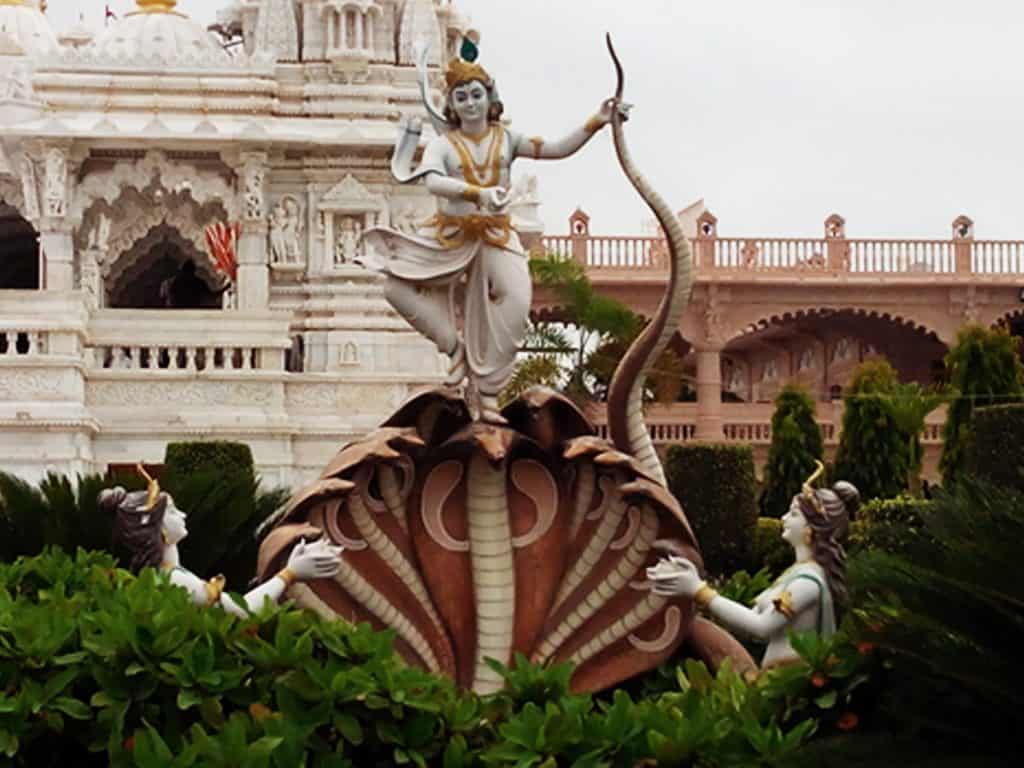Celebrate Nag Panchami with an in-depth look at its rituals and cultural significance. Explore how the ancient festival of Nag Panchami honours serpents and connects devotees with divine blessings.

Nag Panchami, a vibrant and significant Hindu festival, is celebrated with great enthusiasm across India. Devotees come together to worship snakes, seeking to please Lord Shiva and offering milk and other tributes to live cobras. The festivities often include a fast observed the day before Nag Panchami, known as Nag Chaturthi or Nagula Chavithi.
Derived from the Sanskrit words ‘Naga’ (meaning snake) and ‘Panchami’ (denoting the fifth day), Nag Panchami is celebrated on the fifth day of the bright fortnight of the lunar month of Shrawan. This timing is considered auspicious, believed to harness the moon’s positive energies to honour these divine beings.
As the auspicious festival of Nag Panchami approaches, devotees prepare to mark this special day. Shukla Paksha Panchami, or the fifth day of the Sawan month, falls two days after Hariyali Teej, typically in July or August. According to tradition, women pray to the Serpent God, offering milk and seeking protection and prosperity for their brothers and families. If you and your loved ones are celebrating Nag Panchami this year, it’s essential to understand the date, time, puja muhurat, history, significance, and celebrations of this revered festival.
Nag Panchami holds profound significance in Hindu traditions, dedicated to the worship of snakes, which are considered powerful deities. Particularly revered by devotees from the Naga tribe, it is believed that any worship offered to snakes reaches the serpent deities. According to Drik Panchang, twelve specific snakes are worshipped during Nag Panchami puja: Anant, Shesha, Vasuki, Padma, Kambal, Karkotak, Ashvatar, Dritrashtra, Shankhpal, Kaliya, Takshak, and Pingal. Devotees believe that worshipping snakes on this day can help alleviate fears of serpents and resolve Kaal Sarpa Dosh.
Legends of Nag Panchami
Several legends are associated with Nag Panchami in the country. One popular belief recounts that while playing near the Yamuna River, Lord Krishna stepped into the water, where he encountered the serpent Kaliya Nag. After a fierce battle, Krishna defeated Kaliya Nag, who, realizing Krishna’s divine nature, begged for mercy. Krishna spared Kaliya Nag’s life on the condition that he would no longer harm the residents of Gokul. Nag Panchami commemorates Lord Krishna’s victory over Kaliya Nag, symbolizing the triumph of good over evil.
Another legend says that in the Mahabharata, King Janamejaya of the Kuru dynasty performed a snake sacrifice called Sarpa Satra to avenge his father King Parikshita’s death from a snake bite by the serpent king Takshaka.
During the Sarpa Satra, a sacrificial fire was set up by learned Brahmin sages, and the powerful rituals caused all snakes to fall into the fire. Despite Takshaka seeking refuge with Indra, the intensified mantras began pulling both Takshaka and Indra towards the fire. Alarmed, the gods appealed to Manasadevi, who sent her son Astika to stop the yagna.

Astika impressed Janamejaya with his scriptural knowledge, securing a boon to halt the Sarpa Satra. Reluctantly, Janamejaya agreed, sparing the lives of Indra, Takshaka, and other serpents. This event occurred on Nadivardhini Panchami, the fifth day of Shravana’s bright fortnight, now celebrated as Nag Panchami, honouring the spared serpents. Indra also worshipped Manasadevi on this day.
Celebrate Nag Panchami by immersing yourself in the rich traditions, vibrant legends, and deep spiritual significance of this ancient festival. Whether through fasting, prayers, or offerings, this day serves as a powerful reminder of the revered place snakes hold in Hindu culture and spirituality.
How Do We Celebrate Nag Panchami?
Nag Panchami celebrations vary across different regions of India. Devotees traditionally offer milk to live snakes or serpent figures. In some areas, rice pudding and lotus flowers in silver bowls are offered to the Nagas.
A key aspect of the festival is cleaning homes, followed by conducting Nag pujas. Devotees place images or idols of Nag Deva and organize prayers, and lighting lamps during the rituals. Performing Sankalpa, a vow or intention setting, is also a significant part of the Nag pujas.
In certain regions, people create Rangolis of serpents using natural colours. These intricate designs are drawn on the floor of their houses or at the entrance. Some communities also draw images of snakes on doors.
In specific villages, people seek out anthills, offering incense and milk at their bases, and even pouring milk into the anthills to show reverence.
There are many other unique ways to celebrate Nag Panchami, reflecting the rich cultural diversity across India.
Popular Regions Celebrating Nag Panchami
Maharashtra Nag Panchami
In Maharashtra, Nag Panchami is celebrated with great fervour and devotion. The day begins with women waking up early to thoroughly clean their homes and courtyards. They then draw intricate rangoli designs featuring serpents at the entrances of their houses using natural colours. Devotees visit temples dedicated to the Nag deities, such as the popular Bhimashankar Temple in Pune and Nagoba Temple in Nagpur to offer prayers and perform rituals.
West Bengal Nag Panchami
In West Bengal, Nag Panchami is celebrated with distinct rituals and cultural practices. The festival, known locally as “Manasa Puja,” honours Manasa Devi, the serpent goddess believed to control snakes and protect devotees from snake bites. Devotees clean their homes and create altars adorned with clay idols or images of Manasa Devi. These altars are decorated with flowers, vermilion, turmeric, and rice. Women often fast on this day, breaking it only after the rituals are complete. The puja involves offering milk, sweets, fruits, and other delicacies to the goddess.
Devotees also pour milk and water over snake idols as a symbolic act of reverence. Folk songs and dances dedicated to Manasa Devi are performed, and stories of her divine deeds are narrated. In rural areas, it is common for devotees to visit ponds or rivers where snakes are believed to reside, offering prayers and rituals to ensure their safety and prosperity. The festival culminates with a community feast, where families gather to share the offerings and celebrate the blessings of Manasa Devi.
Kerala Nag Panchami
In Kerala, Nag Panchami is celebrated with deep spiritual significance, primarily in temples dedicated to serpent gods, known as “Sarpa Kavu” or sacred groves. The rituals begin with devotees performing “Nag Puja” to honour the serpent deities, seeking their blessings for protection and prosperity.
A unique aspect of the celebration in Kerala is the veneration of Nagaraja, the king of serpents, and Nagayakshi, the serpent goddess, with elaborate rituals. Devotees offer milk, turmeric, and flowers to snake idols and anthills, believed to be the abodes of these deities. Special pujas, including “Noorum Palum” (a mixture of turmeric, milk, and other auspicious items), are conducted to appease the serpent gods.
Women often fast and participate in the rituals, praying for the well-being of their families. Traditional music and dance performances, like the “Sarpam Thullal” ritual dance, are integral to the festivities, symbolizing the divine presence of the serpent deities. The celebrations also involve storytelling sessions, recounting the legends of snake gods and their significance in local folklore, culminating in communal prayers and feasts.
Madhya Pradesh Nag Panchami
In Madhya Pradesh, the Nagchandreshwar Temple in Ujjain is a focal point for Nag Panchami celebrations, attracting thousands of devotees across the region. This unique temple, dedicated to Lord Shiva and the serpent deity Nagchandreshwar, opens its doors to the public only once a year on Nag Panchami. The festivities begin with devotees queuing up early to offer their prayers and seek blessings.
The rituals involve offering milk, flowers, and vermilion to the idol of Nagchandreshwar, which is believed to grant protection from snake bites and other misfortunes. The temple priests perform elaborate pujas and recite sacred mantras, invoking the blessings of the serpent deity. Devotees also offer “Noorum Palum,” a mixture of turmeric, milk, and other auspicious items, to appease the snake god. The atmosphere is charged with spiritual energy as traditional music and chants fill the air.
Many devotees observe fasts and participate in community prayers, hoping to receive divine protection and prosperity. The annual opening of the Nagchandreshwar Temple on Nag Panchami is a deeply revered event, marking a significant cultural and religious milestone in Madhya Pradesh.
Nag Panchami is a festival that transcends mere rituals, embodying a deep-seated reverence for nature and its creatures. Through various customs and traditions, devotees express their respect and gratitude towards the serpent deities, seeking blessings for a prosperous and harmonious life.
The festival’s widespread celebration across different regions of India highlights its cultural significance and the rich tapestry of beliefs that bind the nation together.
Read more: Latest



